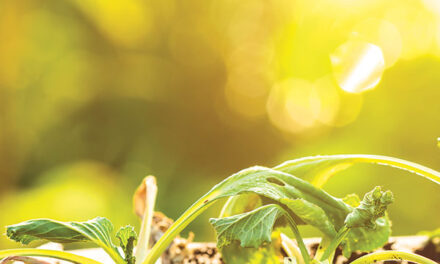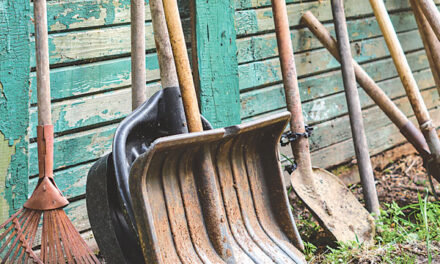Foraging for drip irrigation repair parts, I glanced at my primitive gardening tools. Idling in a corner of the garage, the old-timers had weathered wooden handles and scarred cutting surfaces. The digging fork had a bent tine, courtesy of tree root vs. steel.
I was reminded of the evolution of garden maintenance. Gardening tools arrived when a human picked up a tree branch and gouged out a planting furrow. Bone, wood and stone tools were simple but effective. Replacement parts ample and free.
Today, preferred tools are cordless and powered by lithium-ion and nickel-cadmium batteries. Mowers, trimmers and leaf blowers are encased in combinations of plastic, fiberglass, metal and composites. They drain kilowatt hours, like the EVs that share many garages.

Handles on modern gardening tools are ergonomically designed and are often bright yellow, green, blue and red. Easier to find when left out.
Weeding and edging lawns are now assigned to cordless string trimmers. No need for gasoline or power cords. We have ditched hand pruning shears and rotary lawn edgers that resemble a medieval weapon and are just as exhausting to wield. Full disclosure, I still have a push rotary edger.
Not long ago, landscapes were watered with cast-iron sprinkler heads. Brass replaced cast iron. Now plastic is common. Modern drip irrigation with PVC pipe, plastic tubing and emitters (those tiny holes that allow specific gallons-per-hour of water) was a child of the 1960s and has continued to progress.
Before I installed drip irrigation, I relied on sprinklers. At times, sidewalks received more water than the lawn. Summer evaporation hit criminal levels. Penalties appeared on water bills.
Transitioning from sprinklers to drip irrigation, I removed most of my lawn. My preference is flowers and shrubs. I kept a small square of lawn for the dog’s sake.
For spot watering, I am a hose-dragger. That still saves the day, even with drip irrigation. Hoses have progressed to non-kink and expandable. Non-kink versions eventually kink. Expandable hoses are short lived.
As well intentioned as we can be with drip irrigation, some plant containers will lack a drip line. We get lazy. Or time constraints delay running a new line. Newer hoses may have faults, but keep one handy.
My small square of lawn is mowed with an ancient Sears Craftsman push-reel mower. Yup, you are the engine. Push and cut, pull back and charge ahead for another go at tall grass. “Powered by arm-strong,” is how my father described push mowers.
I once mowed with a power mower, but even then I was a bit odd by neighborhood standards. All my neighbors hired mow-and-blow companies. A swarm of pickup trucks and bodies descended on the street most mornings, double-timing behind power mowers and waving deafening blowers like magic wands.
Home gardeners are partial to cordless leaf blowers. Old reliable leaf rakes too often have been tossed or forgotten. Raking leaves may be a Herculean feat in heavily forested neighborhoods where The Claw prowls in fall. If you still rake your leaves, who needs the gym?
Hoes have declined in popularity. The cordless weed-whacker is faster and there are no blisters. Gardeners have the option to roll out landscape fabric and add bark chips to minimize weeds.
Herbicides sprayed on weeds have relegated the hoe to the back of the tool shed. Keep in mind, non-selective herbicides, like those containing glyphosate, kill all plant life—weeds and precious ornamentals. Keep a sharp edge on the hoe and it can still be a useful and environmentally friendly tool.
Modern gardening tools have benefits and smart tools are on the way. But I have no plans to toss my elderly hoe, hedge shears, push mower and rake. They have been my gardening buddies for years. Later this summer, after a few hours of yard work, I may take them out for a beer.
Dan Vierria is a University of California Cooperative Extension Master Gardener for Sacramento County. He can be reached at masterg29@gmail.com. For answers to gardening questions, contact UCCE Master Gardeners at (916) 876-5338, email mgsacramento@ucanr.edu or visit sacmg.ucanr.edu. Follow us on Facebook and Instagram: @insidesacramento.
















